MAZDA MODEL CX-9 2008 (in English) Service Manual
Manufacturer: MAZDA, Model Year: 2008, Model line: MODEL CX-9, Model: MAZDA MODEL CX-9 2008Pages: 506, PDF Size: 11.52 MB
Page 41 of 506
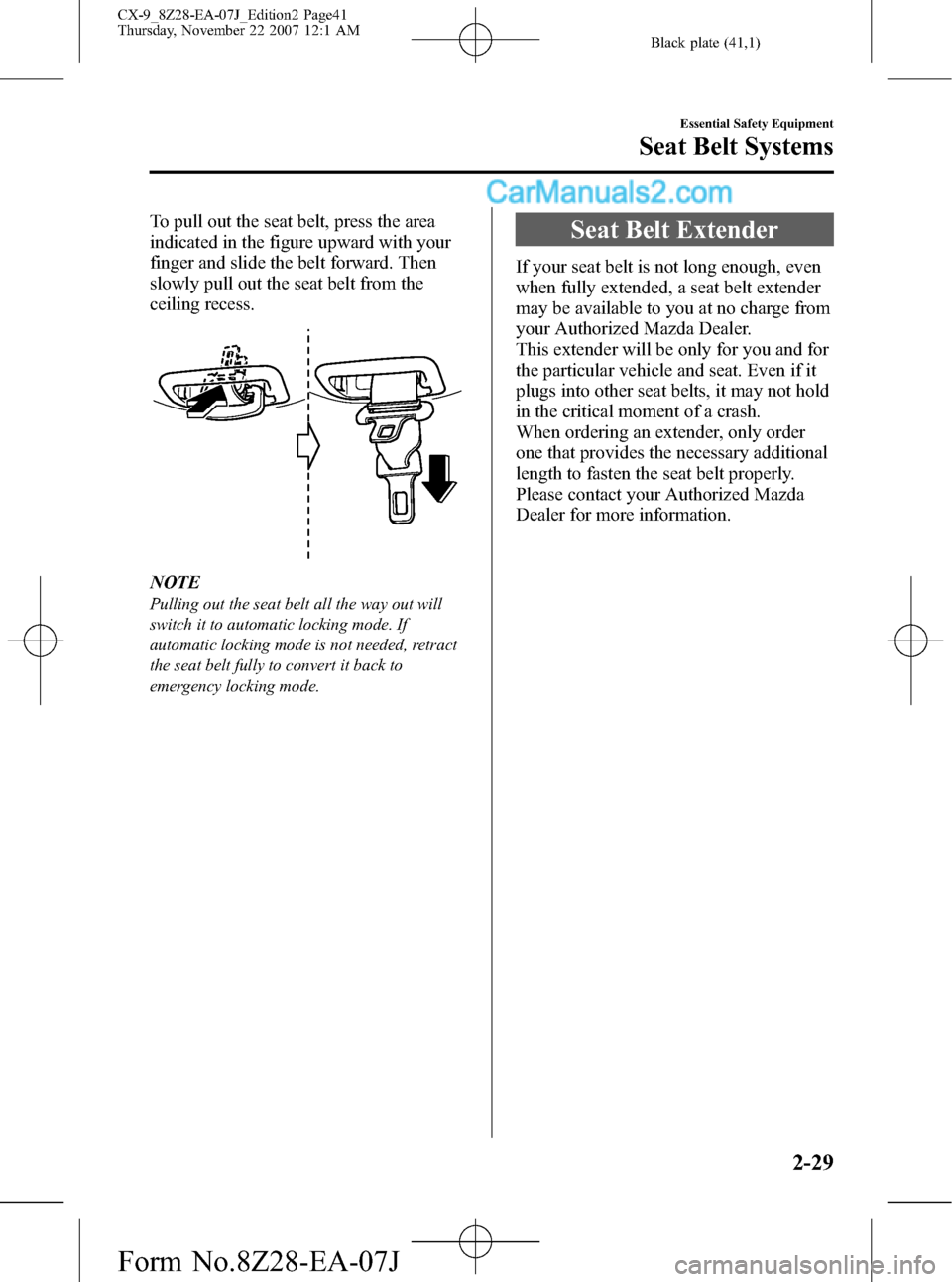
Black plate (41,1)
To pull out the seat belt, press the area
indicated in the figure upward with your
finger and slide the belt forward. Then
slowly pull out the seat belt from the
ceiling recess.
NOTE
Pulling out the seat belt all the way out will
switch it to automatic locking mode. If
automatic locking mode is not needed, retract
the seat belt fully to convert it back to
emergency locking mode.
Seat Belt Extender
If your seat belt is not long enough, even
when fully extended, a seat belt extender
may be available to you at no charge from
your Authorized Mazda Dealer.
This extender will be only for you and for
the particular vehicle and seat. Even if it
plugs into other seat belts, it may not hold
in the critical moment of a crash.
When ordering an extender, only order
one that provides the necessary additional
length to fasten the seat belt properly.
Please contact your Authorized Mazda
Dealer for more information.
Essential Safety Equipment
Seat Belt Systems
2-29
CX-9_8Z28-EA-07J_Edition2 Page41
Thursday, November 22 2007 12:1 AM
Form No.8Z28-EA-07J
Page 42 of 506
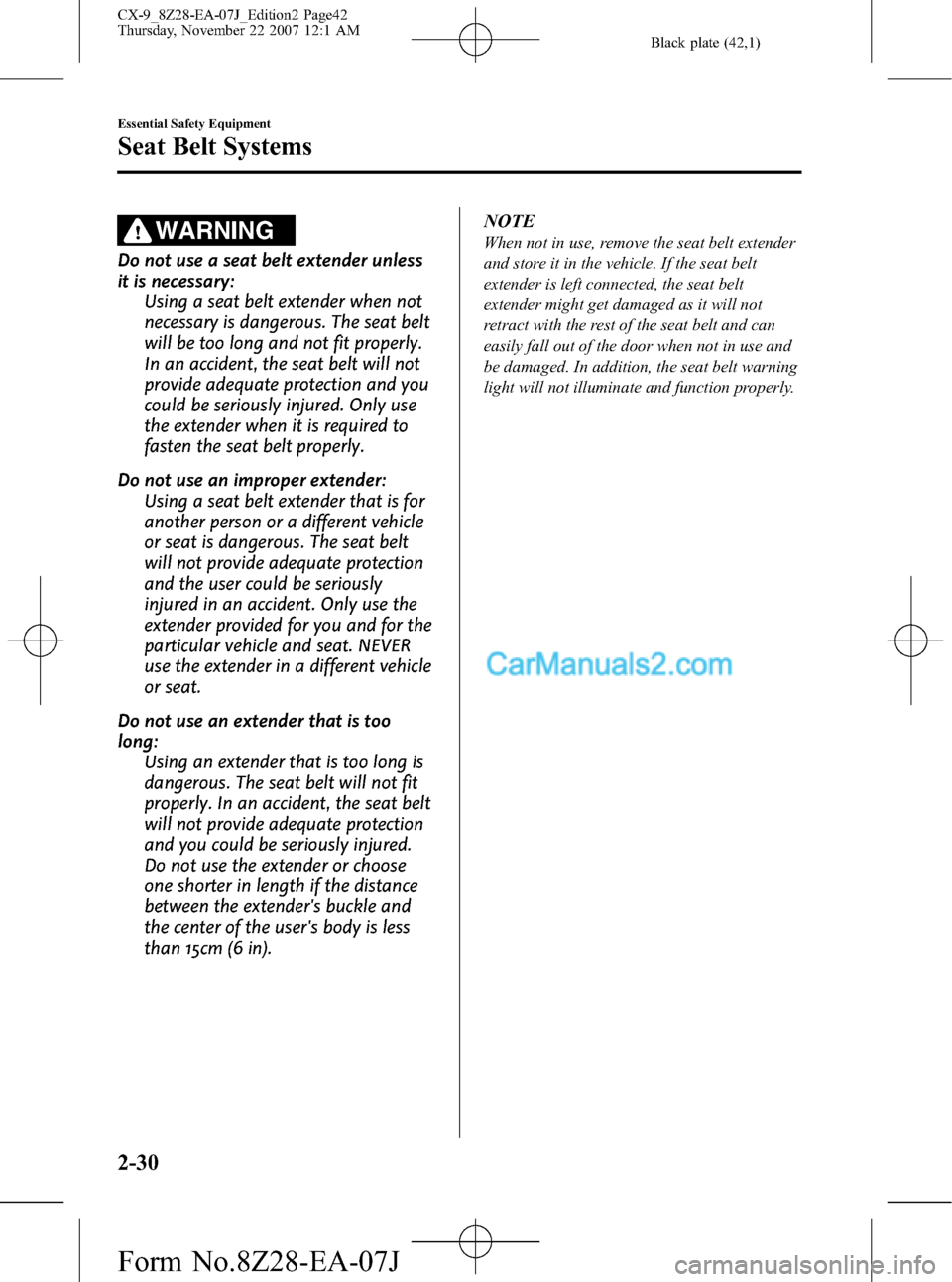
Black plate (42,1)
WARNING
Do not use a seat belt extender unless
it is necessary:
Using a seat belt extender when not
necessary is dangerous. The seat belt
will be too long and not fit properly.
In an accident, the seat belt will not
provide adequate protection and you
could be seriously injured. Only use
the extender when it is required to
fasten the seat belt properly.
Do not use an improper extender:
Using a seat belt extender that is for
another person or a different vehicle
or seat is dangerous. The seat belt
will not provide adequate protection
and the user could be seriously
injured in an accident. Only use the
extender provided for you and for the
particular vehicle and seat. NEVER
use the extender in a different vehicle
or seat.
Do not use an extender that is too
long:
Using an extender that is too long is
dangerous. The seat belt will not fit
properly. In an accident, the seat belt
will not provide adequate protection
and you could be seriously injured.
Do not use the extender or choose
one shorter in length if the distance
between the extender's buckle and
the center of the user's body is less
than 15cm (6 in).NOTEWhen not in use, remove the seat belt extender
and store it in the vehicle. If the seat belt
extender is left connected, the seat belt
extender might get damaged as it will not
retract with the rest of the seat belt and can
easily fall out of the door when not in use and
be damaged. In addition, the seat belt warning
light will not illuminate and function properly.
2-30
Essential Safety Equipment
Seat Belt Systems
CX-9_8Z28-EA-07J_Edition2 Page42
Thursday, November 22 2007 12:1 AM
Form No.8Z28-EA-07J
Page 43 of 506
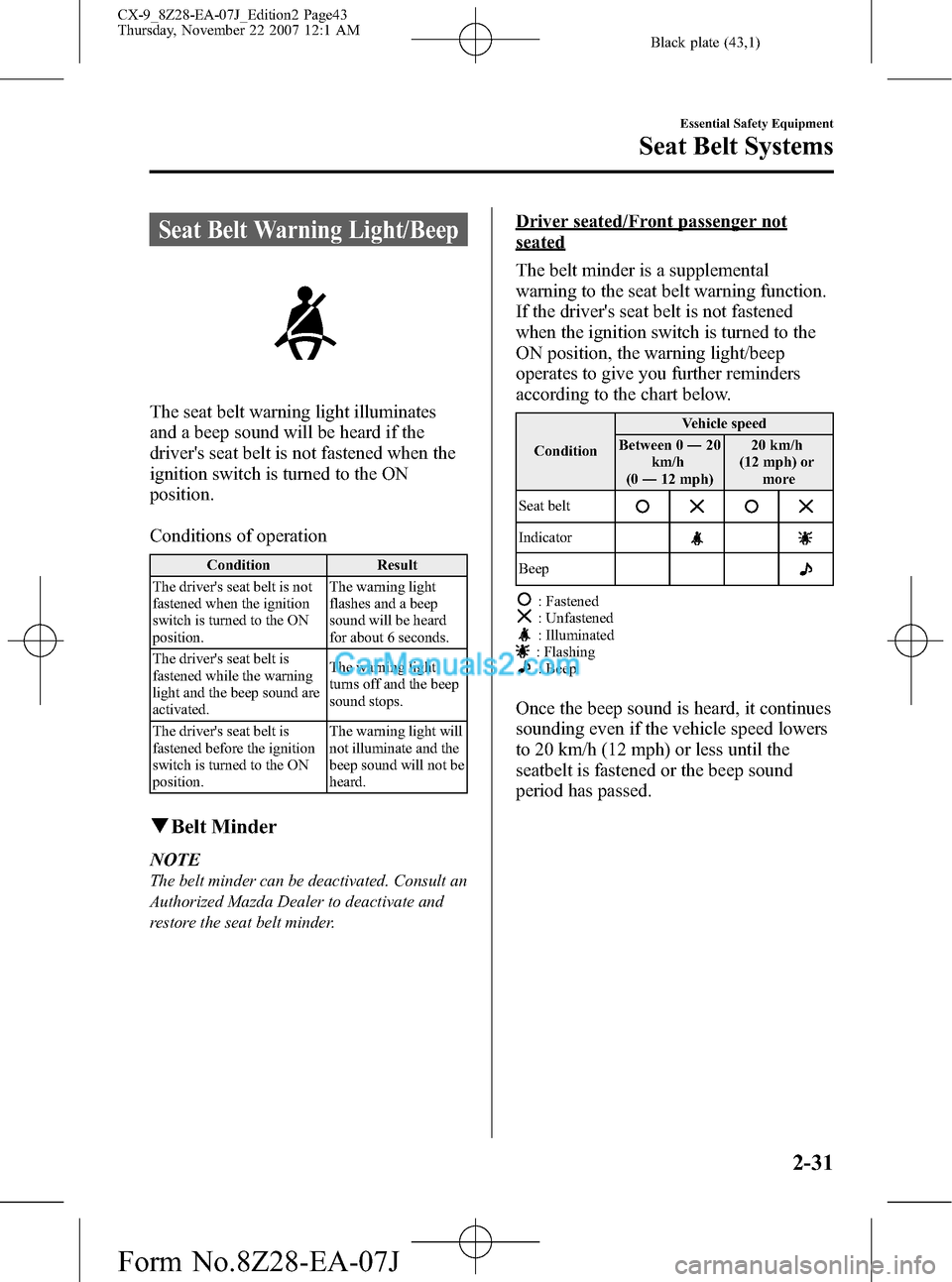
Black plate (43,1)
Seat Belt Warning Light/Beep
The seat belt warning light illuminates
and a beep sound will be heard if the
driver's seat belt is not fastened when the
ignition switch is turned to the ON
position.
Conditions of operation
Condition Result
The driver's seat belt is not
fastened when the ignition
switch is turned to the ON
position.The warning light
flashes and a beep
sound will be heard
for about 6 seconds.
The driver's seat belt is
fastened while the warning
light and the beep sound are
activated.The warning light
turns off and the beep
sound stops.
The driver's seat belt is
fastened before the ignition
switch is turned to the ON
position.The warning light will
not illuminate and the
beep sound will not be
heard.
qBelt Minder
NOTE
The belt minder can be deactivated. Consult an
Authorized Mazda Dealer to deactivate and
restore the seat belt minder.
Driver seated/Front passenger not
seated
The belt minder is a supplemental
warning to the seat belt warning function.
If the driver's seat belt is not fastened
when the ignition switch is turned to the
ON position, the warning light/beep
operates to give you further reminders
according to the chart below.
ConditionVehicle speed
Between 0―20
km/h
(0―12 mph)20 km/h
(12 mph) or
more
Seat belt
Indicator
Beep
: Fastened: Unfastened: Illuminated: Flashing: Beep
Once the beep sound is heard, it continues
sounding even if the vehicle speed lowers
to 20 km/h (12 mph) or less until the
seatbelt is fastened or the beep sound
period has passed.
Essential Safety Equipment
Seat Belt Systems
2-31
CX-9_8Z28-EA-07J_Edition2 Page43
Thursday, November 22 2007 12:1 AM
Form No.8Z28-EA-07J
Page 44 of 506
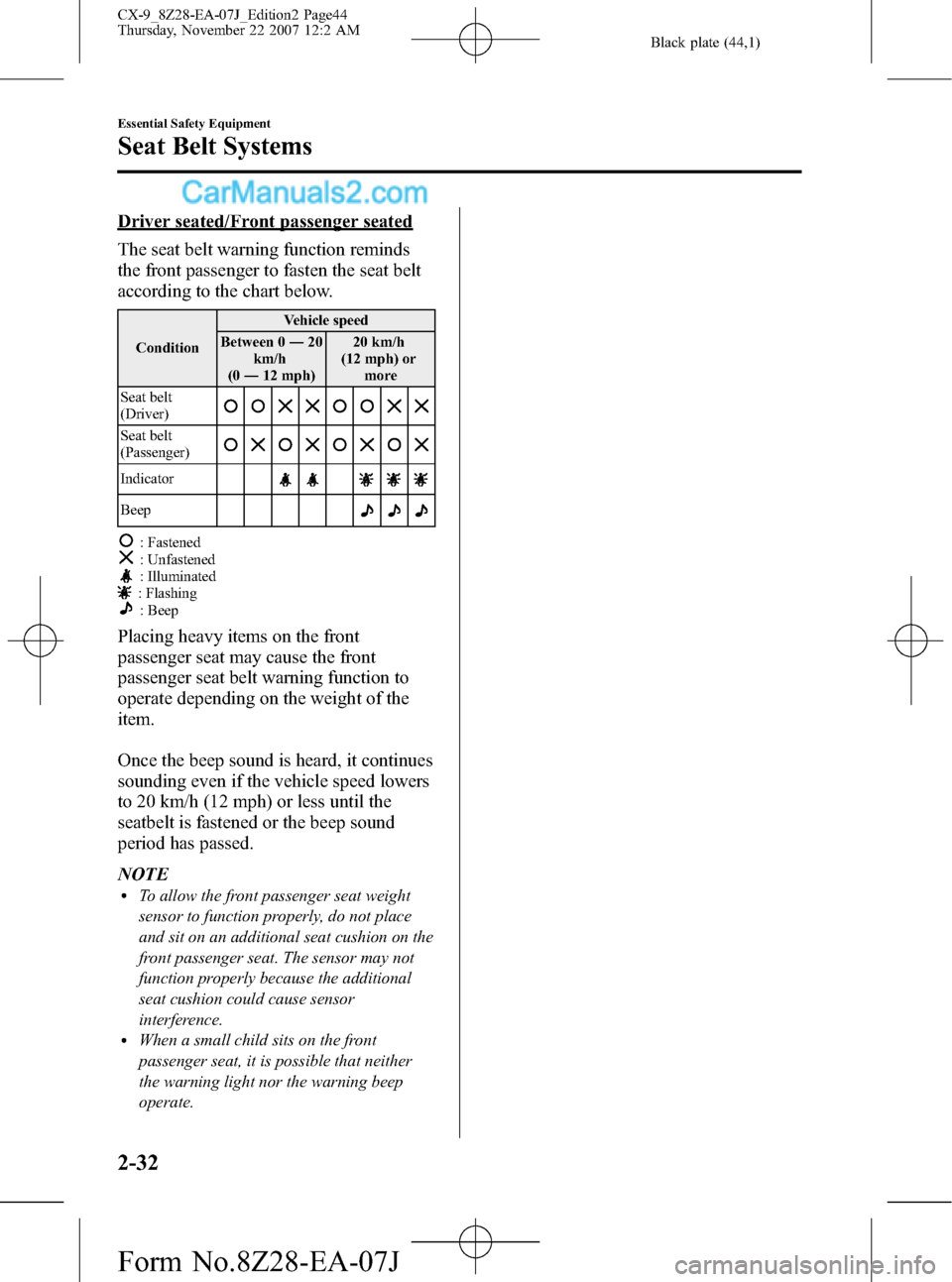
Black plate (44,1)
Driver seated/Front passenger seated
The seat belt warning function reminds
the front passenger to fasten the seat belt
according to the chart below.
ConditionVehicle speed
Between 0―20
km/h
(0―12 mph)20 km/h
(12 mph) or
more
Seat belt
(Driver)
Seat belt
(Passenger)
Indicator
Beep
: Fastened: Unfastened: Illuminated: Flashing: Beep
Placing heavy items on the front
passenger seat may cause the front
passenger seat belt warning function to
operate depending on the weight of the
item.
Once the beep sound is heard, it continues
sounding even if the vehicle speed lowers
to 20 km/h (12 mph) or less until the
seatbelt is fastened or the beep sound
period has passed.
NOTE
lTo allow the front passenger seat weight
sensor to function properly, do not place
and sit on an additional seat cushion on the
front passenger seat. The sensor may not
function properly because the additional
seat cushion could cause sensor
interference.
lWhen a small child sits on the front
passenger seat, it is possible that neither
the warning light nor the warning beep
operate.
2-32
Essential Safety Equipment
Seat Belt Systems
CX-9_8Z28-EA-07J_Edition2 Page44
Thursday, November 22 2007 12:2 AM
Form No.8Z28-EA-07J
Page 45 of 506
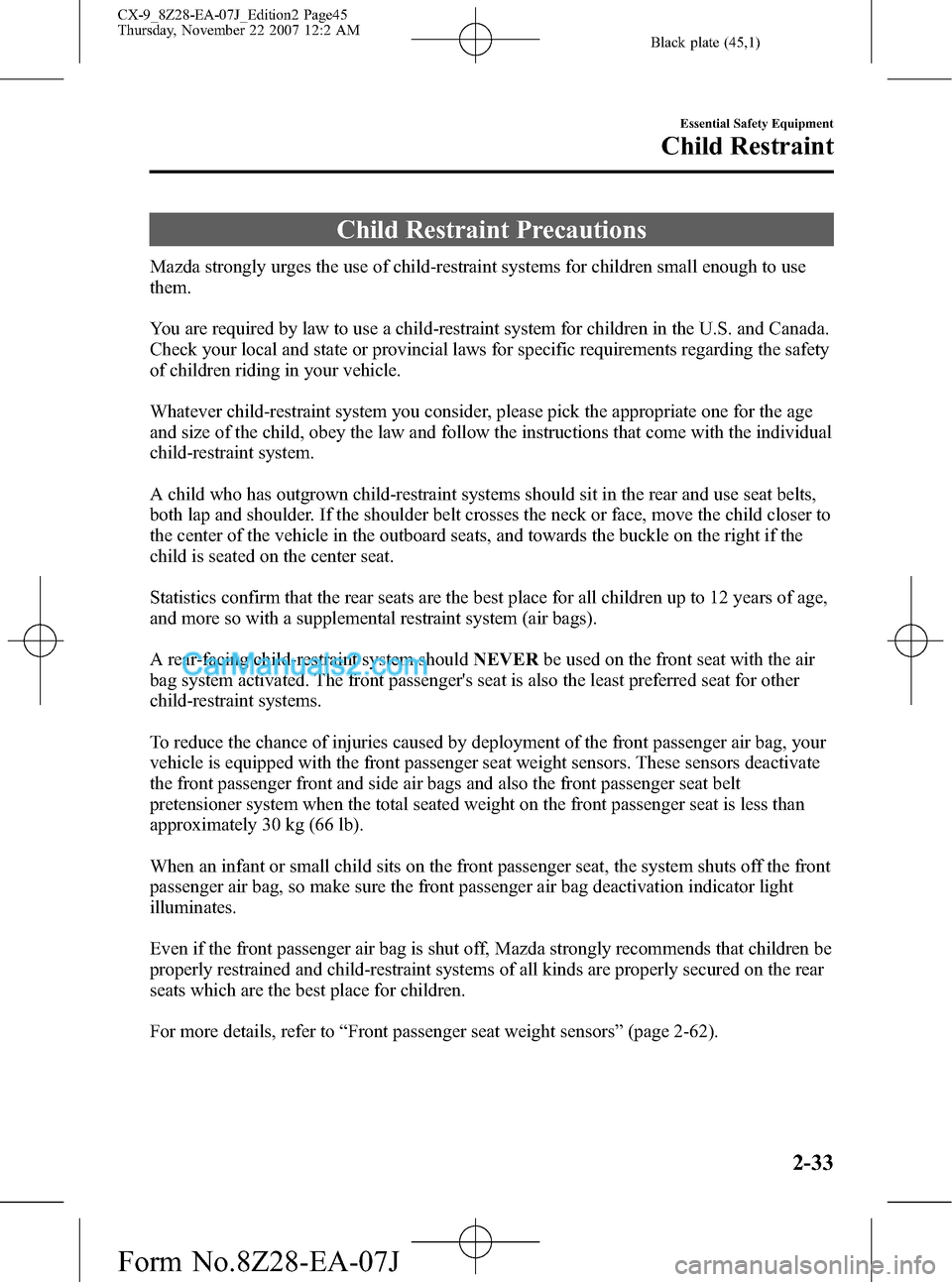
Black plate (45,1)
Child Restraint Precautions
Mazda strongly urges the use of child-restraint systems for children small enough to use
them.
You are required by law to use a child-restraint system for children in the U.S. and Canada.
Check your local and state or provincial laws for specific requirements regarding the safety
of children riding in your vehicle.
Whatever child-restraint system you consider, please pick the appropriate one for the age
and size of the child, obey the law and follow the instructions that come with the individual
child-restraint system.
A child who has outgrown child-restraint systems should sit in the rear and use seat belts,
both lap and shoulder. If the shoulder belt crosses the neck or face, move the child closer to
the center of the vehicle in the outboard seats, and towards the buckle on the right if the
child is seated on the center seat.
Statistics confirm that the rear seats are the best place for all children up to 12 years of age,
and more so with a supplemental restraint system (air bags).
A rear-facing child-restraint system shouldNEVERbe used on the front seat with the air
bag system activated. The front passenger's seat is also the least preferred seat for other
child-restraint systems.
To reduce the chance of injuries caused by deployment of the front passenger air bag, your
vehicle is equipped with the front passenger seat weight sensors. These sensors deactivate
the front passenger front and side air bags and also the front passenger seat belt
pretensioner system when the total seated weight on the front passenger seat is less than
approximately 30 kg (66 lb).
When an infant or small child sits on the front passenger seat, the system shuts off the front
passenger air bag, so make sure the front passenger air bag deactivation indicator light
illuminates.
Even if the front passenger air bag is shut off, Mazda strongly recommends that children be
properly restrained and child-restraint systems of all kinds are properly secured on the rear
seats which are the best place for children.
For more details, refer to“Front passenger seat weight sensors”(page 2-62).
Essential Safety Equipment
Child Restraint
2-33
CX-9_8Z28-EA-07J_Edition2 Page45
Thursday, November 22 2007 12:2 AM
Form No.8Z28-EA-07J
Page 46 of 506
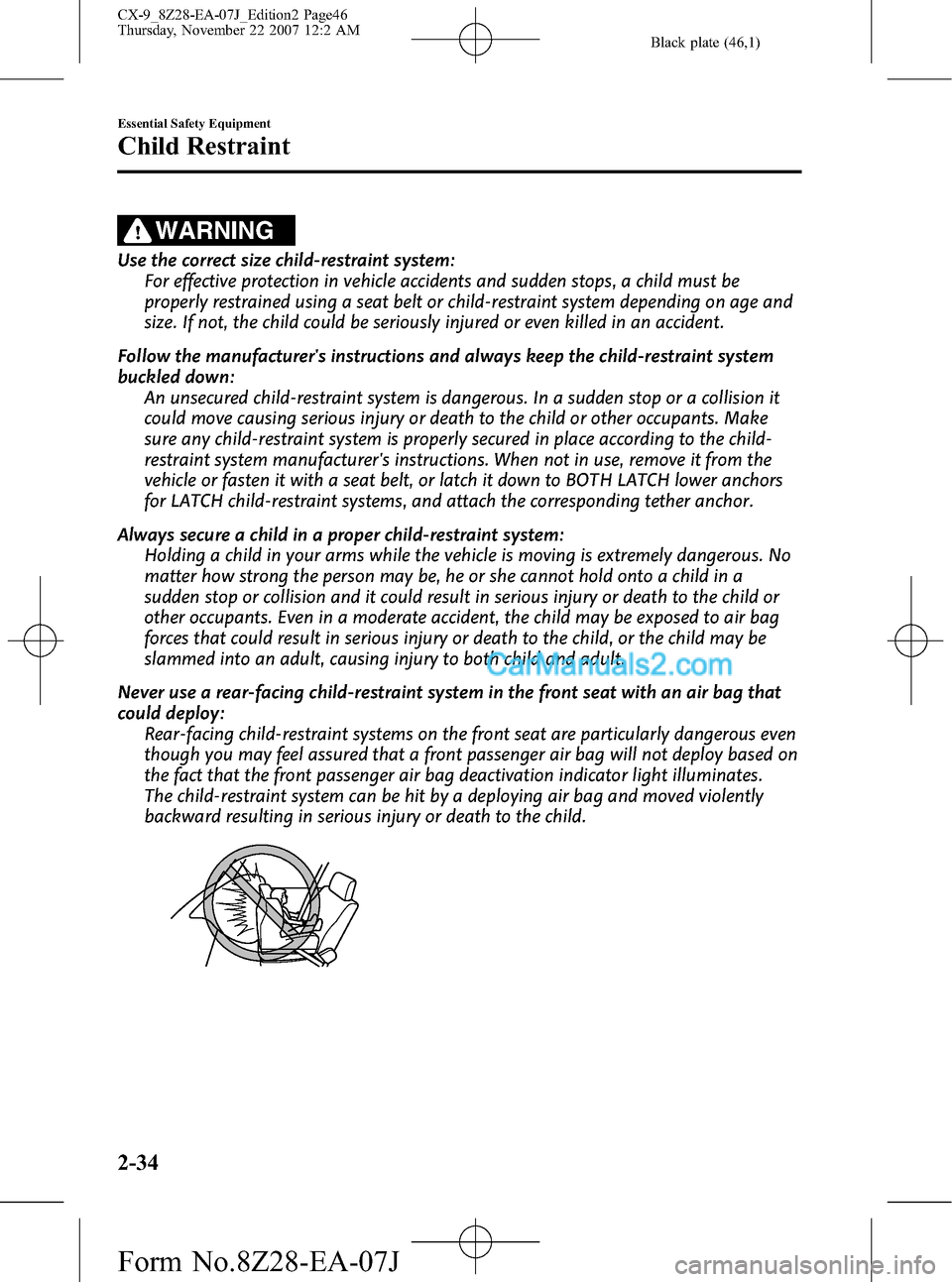
Black plate (46,1)
WARNING
Use the correct size child-restraint system:
For effective protection in vehicle accidents and sudden stops, a child must be
properly restrained using a seat belt or child-restraint system depending on age and
size. If not, the child could be seriously injured or even killed in an accident.
Follow the manufacturer's instructions and always keep the child-restraint system
buckled down:
An unsecured child-restraint system is dangerous. In a sudden stop or a collision it
could move causing serious injury or death to the child or other occupants. Make
sure any child-restraint system is properly secured in place according to the child-
restraint system manufacturer's instructions. When not in use, remove it from the
vehicle or fasten it with a seat belt, or latch it down to BOTH LATCH lower anchors
for LATCH child-restraint systems, and attach the corresponding tether anchor.
Always secure a child in a proper child-restraint system:
Holding a child in your arms while the vehicle is moving is extremely dangerous. No
matter how strong the person may be, he or she cannot hold onto a child in a
sudden stop or collision and it could result in serious injury or death to the child or
other occupants. Even in a moderate accident, the child may be exposed to air bag
forces that could result in serious injury or death to the child, or the child may be
slammed into an adult, causing injury to both child and adult.
Never use a rear-facing child-restraint system in the front seat with an air bag that
could deploy:
Rear-facing child-restraint systems on the front seat are particularly dangerous even
though you may feel assured that a front passenger air bag will not deploy based on
the fact that the front passenger air bag deactivation indicator light illuminates.
The child-restraint system can be hit by a deploying air bag and moved violently
backward resulting in serious injury or death to the child.
2-34
Essential Safety Equipment
Child Restraint
CX-9_8Z28-EA-07J_Edition2 Page46
Thursday, November 22 2007 12:2 AM
Form No.8Z28-EA-07J
Page 47 of 506
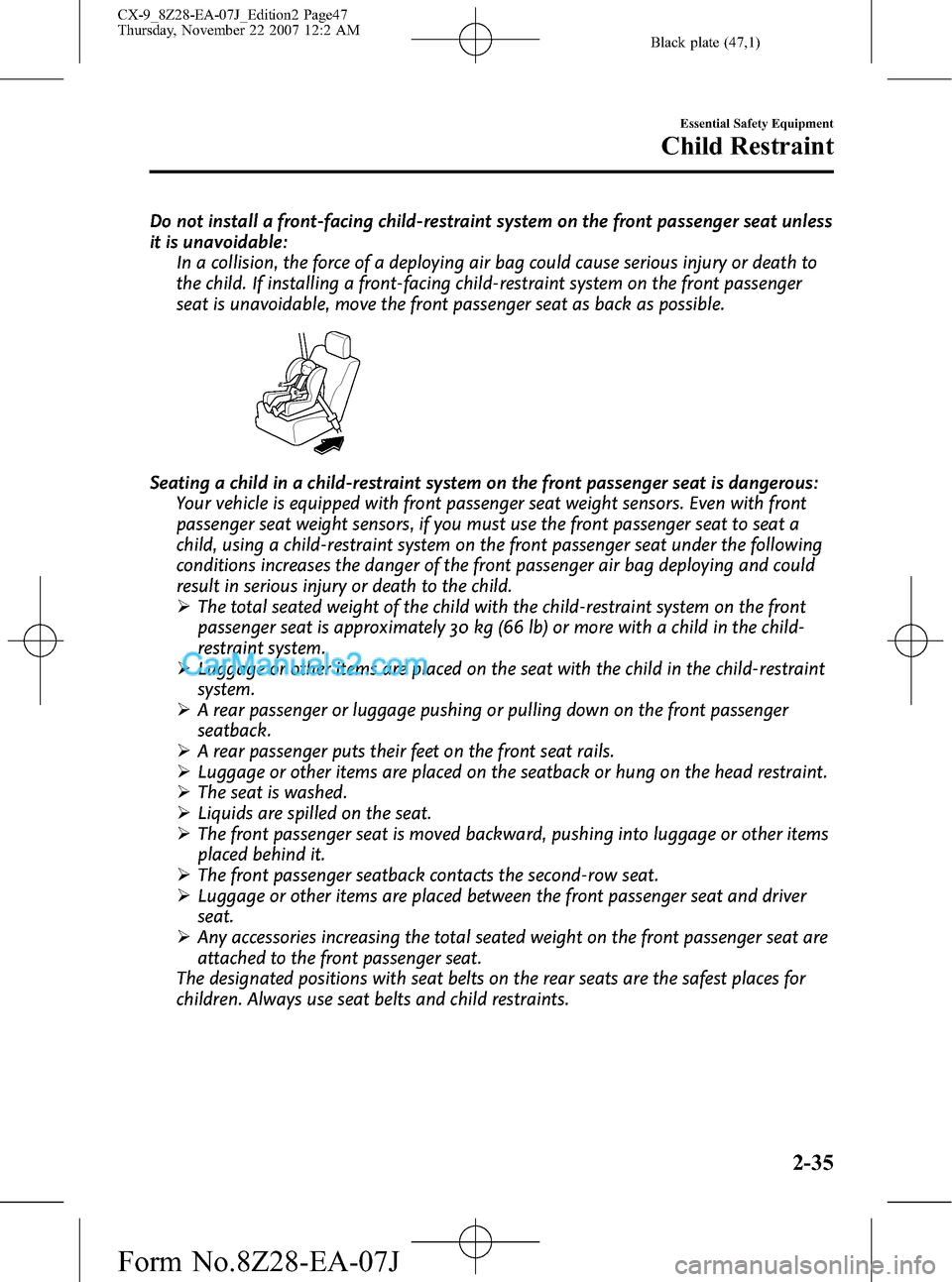
Black plate (47,1)
Do not install a front-facing child-restraint system on the front passenger seat unless
it is unavoidable:
In a collision, the force of a deploying air bag could cause serious injury or death to
the child. If installing a front-facing child-restraint system on the front passenger
seat is unavoidable, move the front passenger seat as back as possible.
Seating a child in a child-restraint system on the front passenger seat is dangerous:
Your vehicle is equipped with front passenger seat weight sensors. Even with front
passenger seat weight sensors, if you must use the front passenger seat to seat a
child, using a child-restraint system on the front passenger seat under the following
conditions increases the danger of the front passenger air bag deploying and could
result in serious injury or death to the child.
ØThe total seated weight of the child with the child-restraint system on the front
passenger seat is approximately 30 kg (66 lb) or more with a child in the child-
restraint system.
ØLuggage or other items are placed on the seat with the child in the child-restraint
system.
ØA rear passenger or luggage pushing or pulling down on the front passenger
seatback.
ØA rear passenger puts their feet on the front seat rails.
ØLuggage or other items are placed on the seatback or hung on the head restraint.
ØThe seat is washed.
ØLiquids are spilled on the seat.
ØThe front passenger seat is moved backward, pushing into luggage or other items
placed behind it.
ØThe front passenger seatback contacts the second-row seat.
ØLuggage or other items are placed between the front passenger seat and driver
seat.
ØAny accessories increasing the total seated weight on the front passenger seat are
attached to the front passenger seat.
The designated positions with seat belts on the rear seats are the safest places for
children. Always use seat belts and child restraints.
Essential Safety Equipment
Child Restraint
2-35
CX-9_8Z28-EA-07J_Edition2 Page47
Thursday, November 22 2007 12:2 AM
Form No.8Z28-EA-07J
Page 48 of 506
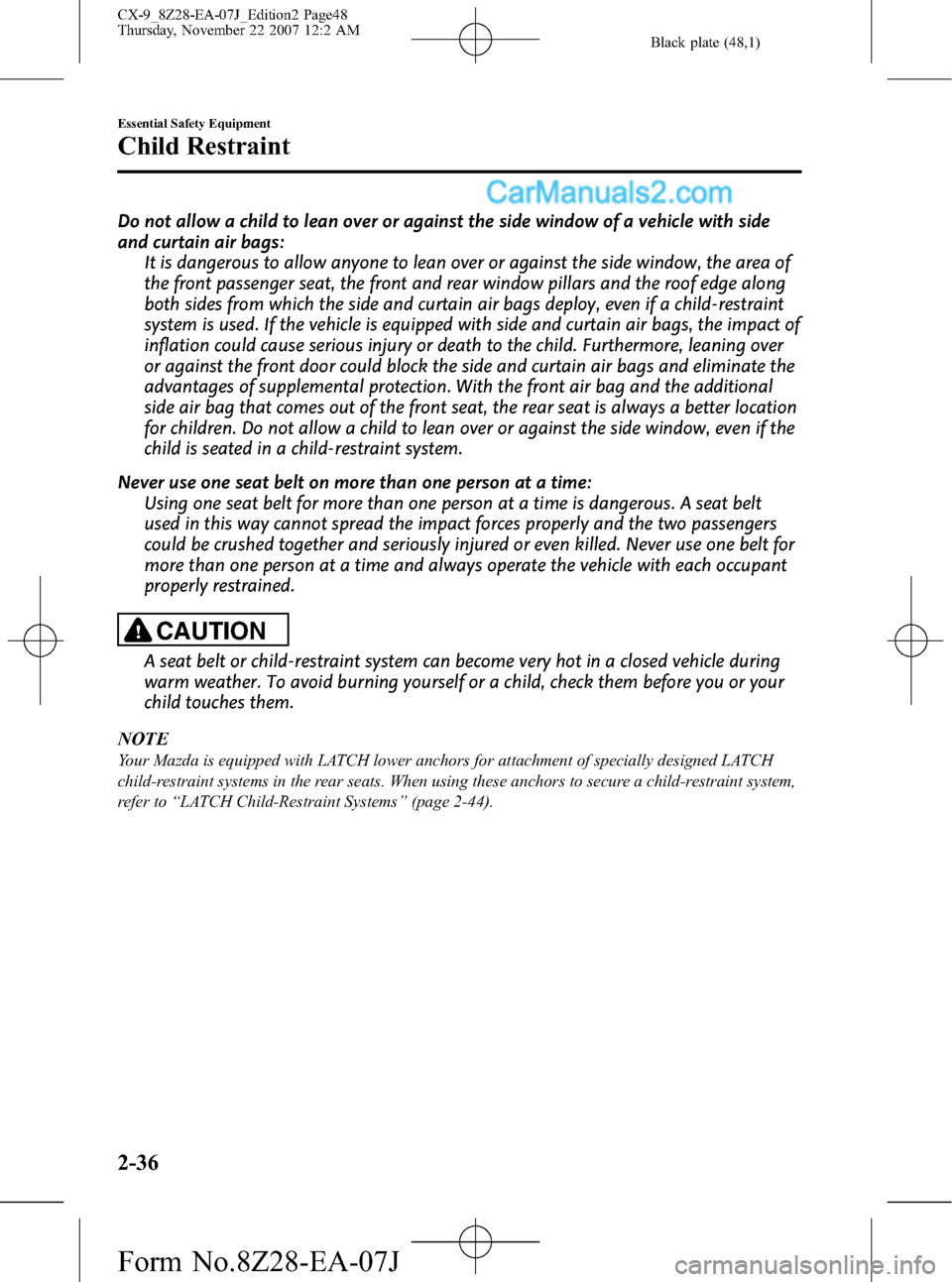
Black plate (48,1)
Do not allow a child to lean over or against the side window of a vehicle with side
and curtain air bags:
It is dangerous to allow anyone to lean over or against the side window, the area of
the front passenger seat, the front and rear window pillars and the roof edge along
both sides from which the side and curtain air bags deploy, even if a child-restraint
system is used. If the vehicle is equipped with side and curtain air bags, the impact of
inflation could cause serious injury or death to the child. Furthermore, leaning over
or against the front door could block the side and curtain air bags and eliminate the
advantages of supplemental protection. With the front air bag and the additional
side air bag that comes out of the front seat, the rear seat is always a better location
for children. Do not allow a child to lean over or against the side window, even if the
child is seated in a child-restraint system.
Never use one seat belt on more than one person at a time:
Using one seat belt for more than one person at a time is dangerous. A seat belt
used in this way cannot spread the impact forces properly and the two passengers
could be crushed together and seriously injured or even killed. Never use one belt for
more than one person at a time and always operate the vehicle with each occupant
properly restrained.
CAUTION
A seat belt or child-restraint system can become very hot in a closed vehicle during
warm weather. To avoid burning yourself or a child, check them before you or your
child touches them.
NOTE
Your Mazda is equipped with LATCH lower anchors for attachment of specially designed LATCH
child-restraint systems in the rear seats. When using these anchors to secure a child-restraint system,
refer to“LATCH Child-Restraint Systems”(page 2-44).
2-36
Essential Safety Equipment
Child Restraint
CX-9_8Z28-EA-07J_Edition2 Page48
Thursday, November 22 2007 12:2 AM
Form No.8Z28-EA-07J
Page 49 of 506
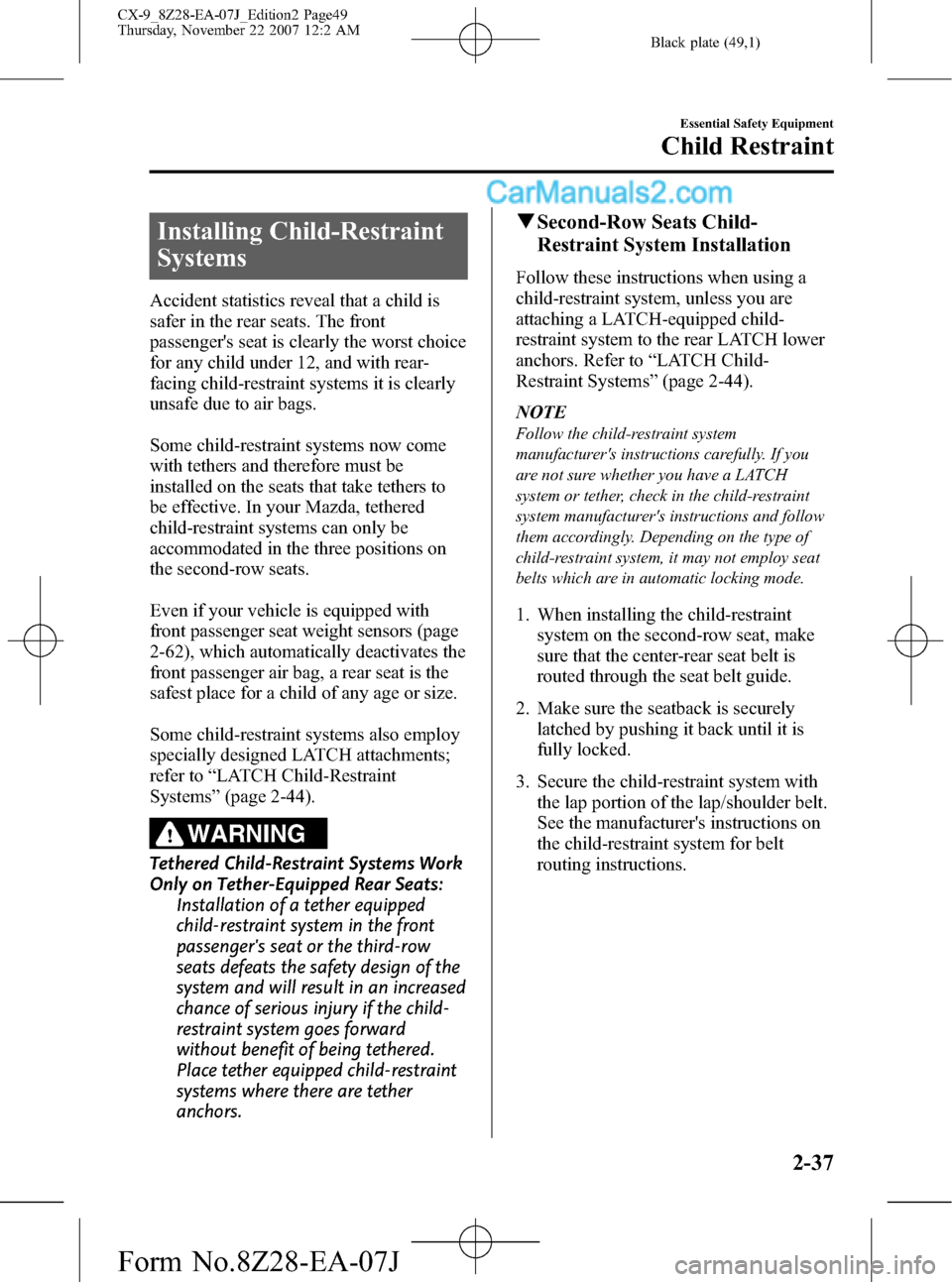
Black plate (49,1)
Installing Child-Restraint
Systems
Accident statistics reveal that a child is
safer in the rear seats. The front
passenger's seat is clearly the worst choice
for any child under 12, and with rear-
facing child-restraint systems it is clearly
unsafe due to air bags.
Some child-restraint systems now come
with tethers and therefore must be
installed on the seats that take tethers to
be effective. In your Mazda, tethered
child-restraint systems can only be
accommodated in the three positions on
the second-row seats.
Even if your vehicle is equipped with
front passenger seat weight sensors (page
2-62), which automatically deactivates the
front passenger air bag, a rear seat is the
safest place for a child of any age or size.
Some child-restraint systems also employ
specially designed LATCH attachments;
refer to“LATCH Child-Restraint
Systems”(page 2-44).
WARNING
Tethered Child-Restraint Systems Work
Only on Tether-Equipped Rear Seats:
Installation of a tether equipped
child-restraint system in the front
passenger's seat or the third-row
seats defeats the safety design of the
system and will result in an increased
chance of serious injury if the child-
restraint system goes forward
without benefit of being tethered.
Place tether equipped child-restraint
systems where there are tether
anchors.
qSecond-Row Seats Child-
Restraint System Installation
Follow these instructions when using a
child-restraint system, unless you are
attaching a LATCH-equipped child-
restraint system to the rear LATCH lower
anchors. Refer to“LATCH Child-
Restraint Systems”(page 2-44).
NOTE
Follow the child-restraint system
manufacturer's instructions carefully. If you
are not sure whether you have a LATCH
system or tether, check in the child-restraint
system manufacturer's instructions and follow
them accordingly. Depending on the type of
child-restraint system, it may not employ seat
belts which are in automatic locking mode.
1. When installing the child-restraint
system on the second-row seat, make
sure that the center-rear seat belt is
routed through the seat belt guide.
2. Make sure the seatback is securely
latched by pushing it back until it is
fully locked.
3. Secure the child-restraint system with
the lap portion of the lap/shoulder belt.
See the manufacturer's instructions on
the child-restraint system for belt
routing instructions.
Essential Safety Equipment
Child Restraint
2-37
CX-9_8Z28-EA-07J_Edition2 Page49
Thursday, November 22 2007 12:2 AM
Form No.8Z28-EA-07J
Page 50 of 506
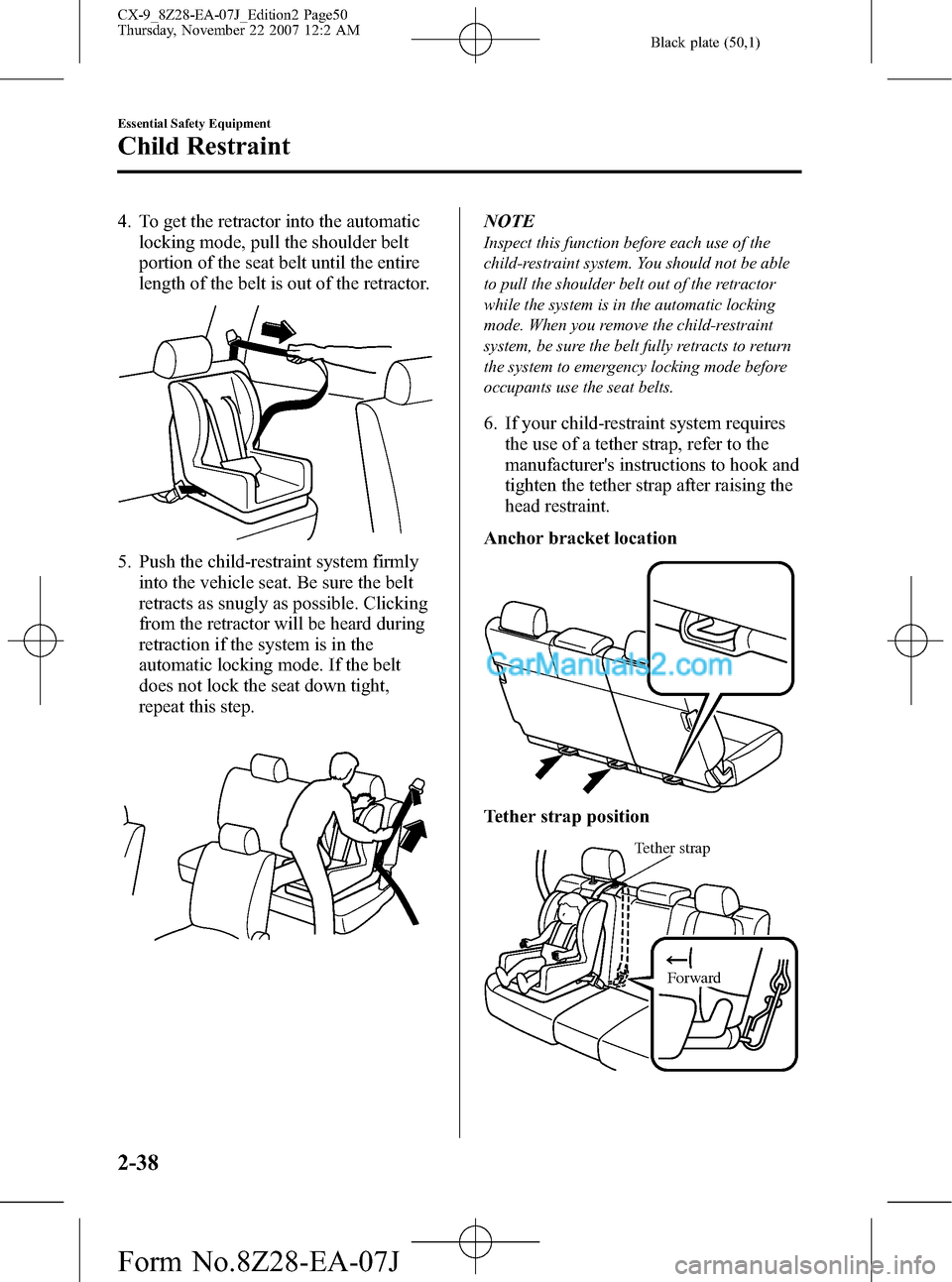
Black plate (50,1)
4. To get the retractor into the automatic
locking mode, pull the shoulder belt
portion of the seat belt until the entire
length of the belt is out of the retractor.
5. Push the child-restraint system firmly
into the vehicle seat. Be sure the belt
retracts as snugly as possible. Clicking
from the retractor will be heard during
retraction if the system is in the
automatic locking mode. If the belt
does not lock the seat down tight,
repeat this step.
NOTE
Inspect this function before each use of the
child-restraint system. You should not be able
to pull the shoulder belt out of the retractor
while the system is in the automatic locking
mode. When you remove the child-restraint
system, be sure the belt fully retracts to return
the system to emergency locking mode before
occupants use the seat belts.
6. If your child-restraint system requires
the use of a tether strap, refer to the
manufacturer's instructions to hook and
tighten the tether strap after raising the
head restraint.
Anchor bracket location
Tether strap position
Tether strap
Forward
2-38
Essential Safety Equipment
Child Restraint
CX-9_8Z28-EA-07J_Edition2 Page50
Thursday, November 22 2007 12:2 AM
Form No.8Z28-EA-07J